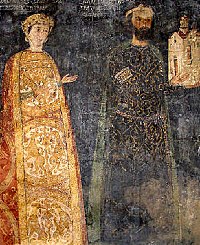Boyana Church
| Boyana Church | |
|---|---|
|
UNESCO world heritage |
|

|
|
| National territory: |
|
| Type: | Culture |
| Criteria : | (ii) (iii) |
| Surface: | 0.68 ha |
| Buffer zone: | 13.55 hectares |
| Reference No .: | 42 |
| UNESCO region : | Europe and North America |
| History of enrollment | |
| Enrollment: | 1979 ( session 3 ) |
The Boyana Church also Boyana Church ( Bulgarian Боянска църква ) is a medieval Bulgarian Orthodox church in the same municipality of Sofia , capital of Bulgaria . It is dedicated to Saint Nicholas and Pantaleimon (Bulgarian: Никола и Пантелеймон). The church was added to the UNESCO World Heritage List in 1979. It is one of the 100 national tourist objects and also a museum, branch of the National Historical Museum in Sofia.
location
The church is located at the foot of the Vitosha Mountains , around 9 km south of the center of the Bulgarian capital. The National Historical Museum is also nearby . In the Middle Ages there was also a fortress called Bojana here . It served as the residence of the administrators of the province of Sredetz, as Sofia was then called.
Building history
The building has three phases from the 10th, 13th and 19th centuries.
Since the church was in danger of being demolished to make room for the construction of a larger building, Tsarina Eleonore , wife of Tsar Ferdinand I of Bulgaria , campaigned for its preservation. She donated money for the purchase of land and the construction of a new church, and from 1912 also supported the restoration of the historic church building.
Frescoes
The church owes its worldwide fame to its frescoes from 1259. These are the second layer on top of even older paintings and represent a very well-preserved example of medieval Eastern European art. On the walls there are depictions of 240 people in 89 different scenes. The name of the painter is not known, his style most likely belonged to the Tarnowo Art School . With his humanistic tendencies, his work not only reflected the reform efforts evident in the 13th century within the Orthodox Church, but also made its own contribution to the demarcation of medieval Bulgarian from Byzantine art. The frescoes are often considered a pinnacle of the art of the Second Bulgarian Empire .
18 scenes in the narthex depict the life of St. Nicholas . Others show scenes from everyday life at that time. Particularly interesting are the portrayals of the church's founders, the Sebastokrator Kalojan and his wife Dessislawa, as well as the Bulgarian Tsar Konstantin Tich Assen and his wife Irina.
Church environment
There are a number of tombs around the church. Of these, the simple entombment for Tsarina Eleonore of Bulgaria († September 12, 1917), the wife of Tsar Ferdinand I of Bulgaria, is particularly noteworthy. The grave area, devastated during the communist regime, was restored after 1990.
literature
- André Grabar : L'église de Boiana / Bojanskata cǎrkva. Sofia, Bǎlgarski Archeologičeski Institute 1924
- Krastju Mijatev : The wall paintings in Boyana. Dresden, Verlag der Kunst; Sofia, Bulgarski Hudoshnik 1961
- Philipp Schweinfurth : The frescoes by Bojana. A masterpiece of monumental art of the 13th century. Mainz, Berlin, Kupferberg 1965
Individual evidence
- ↑ Hans-Joachim Böttcher: Ferdinand von Sachsen-Coburg and Gotha 1861-1948 - A cosmopolitan on the Bulgarian throne . Osteuropazentrum Berlin-Verlag (Anthea Verlagsgruppe), Berlin 2019, ISBN 978-3-89998-296-1 , p. 326-327 .
- ^ Gerhard Ecker: Bulgaria. Art monuments from four millennia from the Thracians to the present. DuMont Buchverlag, Cologne, 1984, pp. 22-23
Web links
- Entry on the UNESCO World Heritage Center website ( English and French ).
- Website of the Boyana Church
Coordinates: 42 ° 38 ′ 40.7 " N , 23 ° 15 ′ 58.3" E


